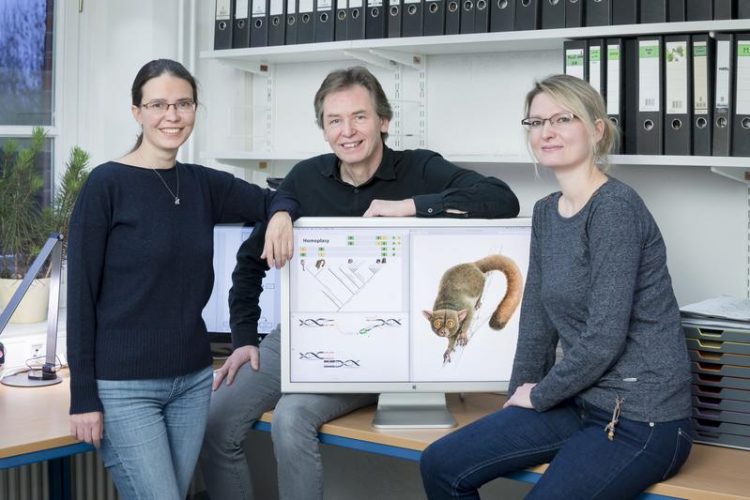Unique jumps in the genome

Dr. Liliya Doronina, PD Dr. Jürgen Schmitz and biology student Olga Reising are excited about the publication of their study. FZ / Tronquet
Mobile elements or retrotransposons occupy more than half of the human genome. Once they were described as genomic parasites, but it is now realised that they have a more complex and multifaceted influence on our existence. On the one hand, they can fortuitously acquire important functions influencing the structure and regulation of our genes.
On the other hand, uncontrolled multiple jumps can lead to genetic diseases and mistakes in gene regulation and can cause cancer. During evolution, our organism developed a defence system to minimize the activity of mobile elements and their harmful impacts. However, although most of our mobile elements, inherited from our mammalian ancestors, are inactive, some elements retain their activity and up to fifty diseases are known to be caused by retrotransposons.
As a practical by-product, the insertion patterns of mobile elements can serve as markers of the evolutionary relatedness of their carriers. Genomic mobile elements shared by two species indicate a shared ancestry of their carriers, as long as the elements did not jump independently into the same genomic places in the two species or were not removed exactly from either of the genomes, both of which lead to the occurrence of false positive phylogenetic signals, also known as homoplasy (from Greek homos=same; plasis=form).
Therefore, to reliably use these markers, it is essential to know how frequently such independent retrotransposon jumps may hit the same target site in genomes and how often they are exactly deleted.
Liliya Doronina and her colleagues from the group of Jürgen Schmitz in the Medical Faculty of the University of Münster in Germany, investigated exactly these questions: (1) how frequently do mobile elements independently insert into an identical genomic place in two organisms and (2) how frequently are established mobile elements exactly excised from their genomic locus.
They analyzed hundreds of thousands of unique retrotransposon insertions in human and other primate genomes. Only a very few cases of parallel retrotransposon insertions and precise deletions were found, confirming that these events are extremely rare.
Due to their uniqueness and irreversibility, retrotransposon insertion patterns are therefore reliable sources for identifying the evolutionary relatedness among species, even among those with complex evolutionary histories, and are indeed excellent markers to reconstruct evolutionary trees.
The presence of a retrotransposon in the same genomic position in several species does indeed indicate their common origin. Moreover, in light of the new study, the potential risk of recurring mobile element insertion-caused genetic diseases is nearly excluded.
The study is entitled “True Homoplasy of Retrotransposon Insertions in Primates” by Liliya Doronina, Olga Reising, Hiram Clawson, David A. Ray, and Jürgen Schmitz, and is now published in the journal Systematic Biology.
Dr. Liliya Doronina
University of Münster
Center for Molecular Biology of Inflammation
Von-Esmarch-Straße 56, 48149 Münster
Tel.: 0251 83 52101
Liliya.Doronina@wwu.de
Doronina L. et al. True Homoplasy of Retrotransposon Insertions in Primates. Systematic Biology, Volume 68, Issue 3, May 2019, Pages 482–493, https://doi.org/10.1093/sysbio/syy076
Media Contact
More Information:
https://www.uni-muenster.de/All latest news from the category: Life Sciences and Chemistry
Articles and reports from the Life Sciences and chemistry area deal with applied and basic research into modern biology, chemistry and human medicine.
Valuable information can be found on a range of life sciences fields including bacteriology, biochemistry, bionics, bioinformatics, biophysics, biotechnology, genetics, geobotany, human biology, marine biology, microbiology, molecular biology, cellular biology, zoology, bioinorganic chemistry, microchemistry and environmental chemistry.
Newest articles

Bringing bio-inspired robots to life
Nebraska researcher Eric Markvicka gets NSF CAREER Award to pursue manufacture of novel materials for soft robotics and stretchable electronics. Engineers are increasingly eager to develop robots that mimic the…

Bella moths use poison to attract mates
Scientists are closer to finding out how. Pyrrolizidine alkaloids are as bitter and toxic as they are hard to pronounce. They’re produced by several different types of plants and are…

AI tool creates ‘synthetic’ images of cells
…for enhanced microscopy analysis. Observing individual cells through microscopes can reveal a range of important cell biological phenomena that frequently play a role in human diseases, but the process of…





















